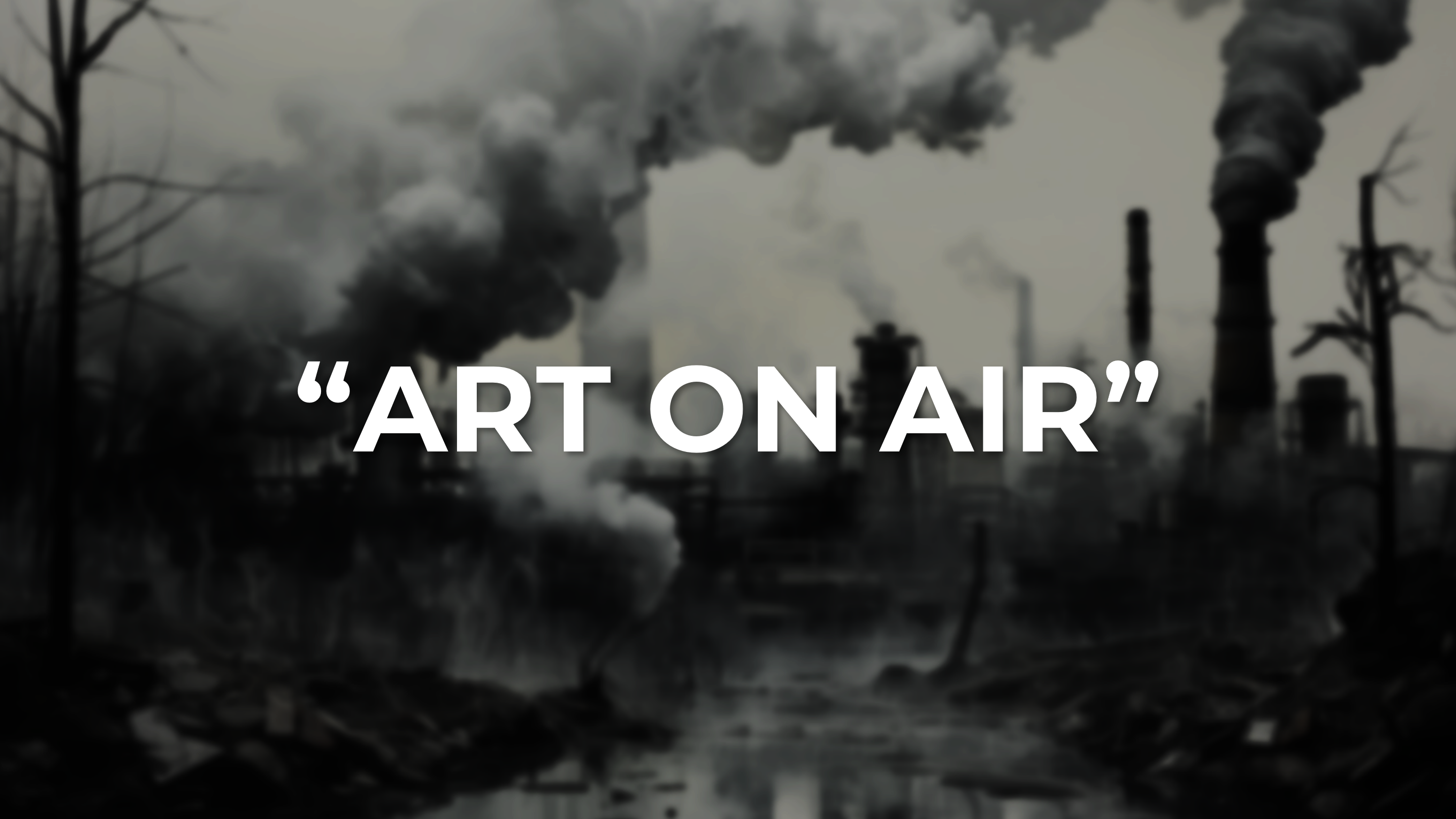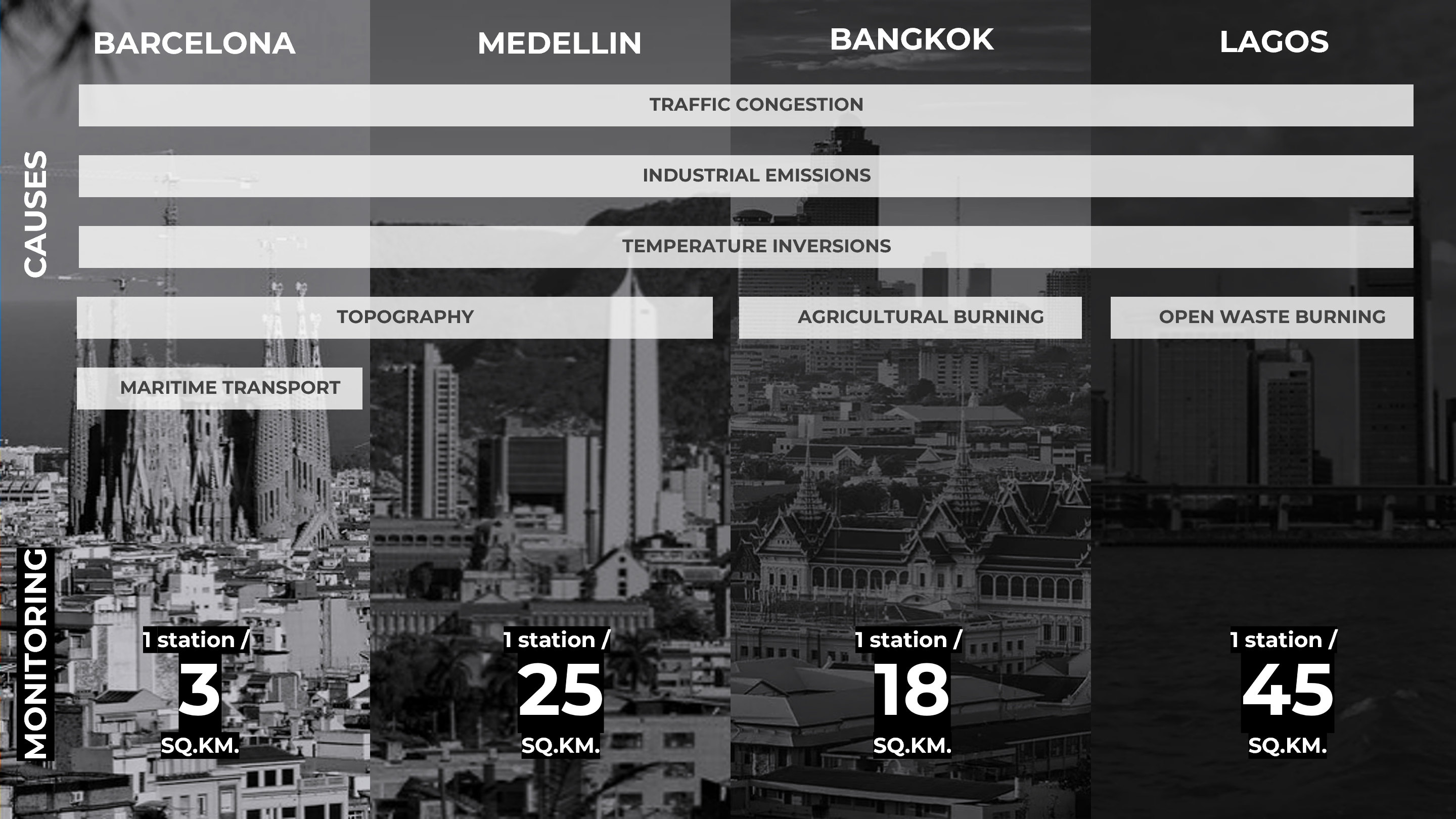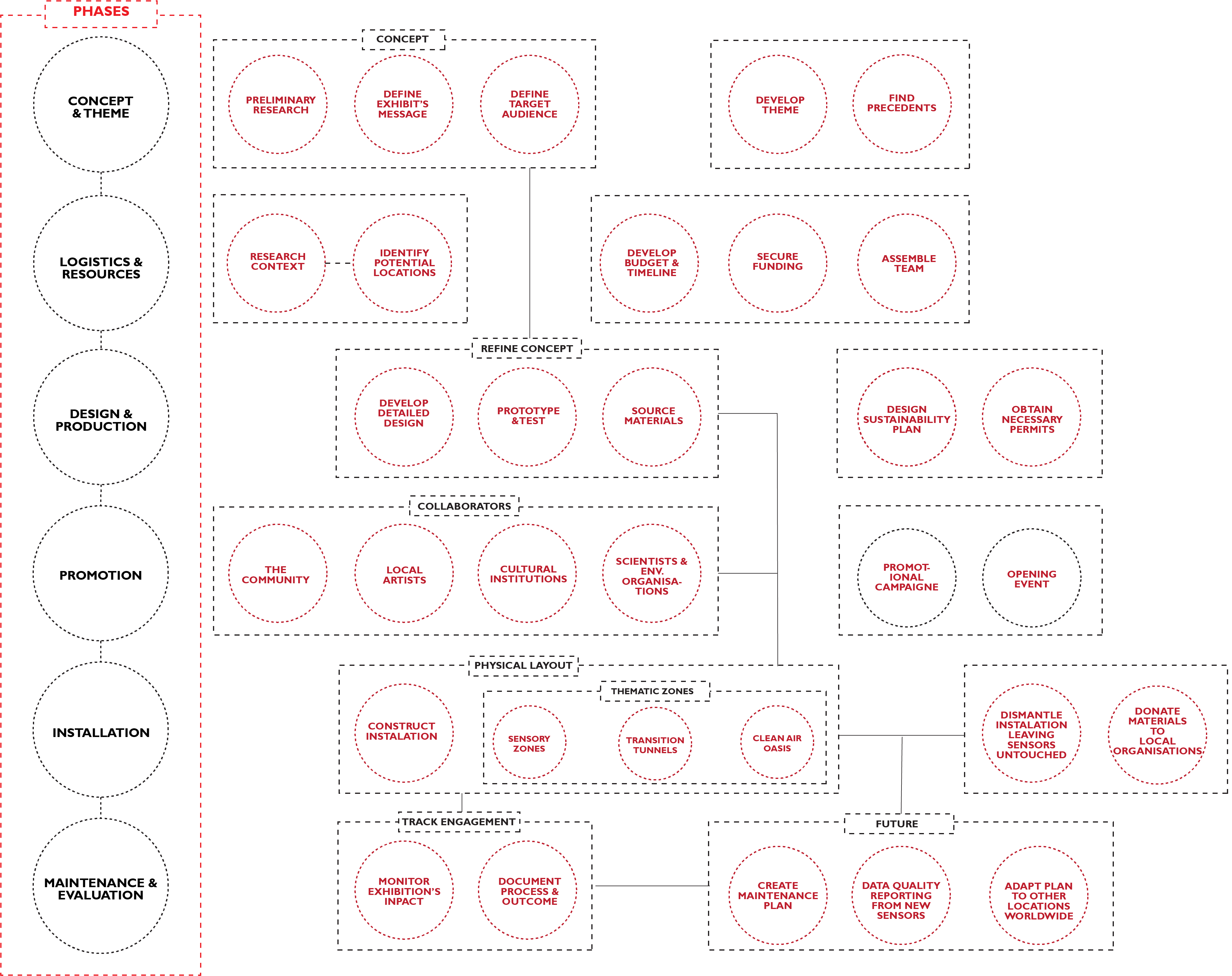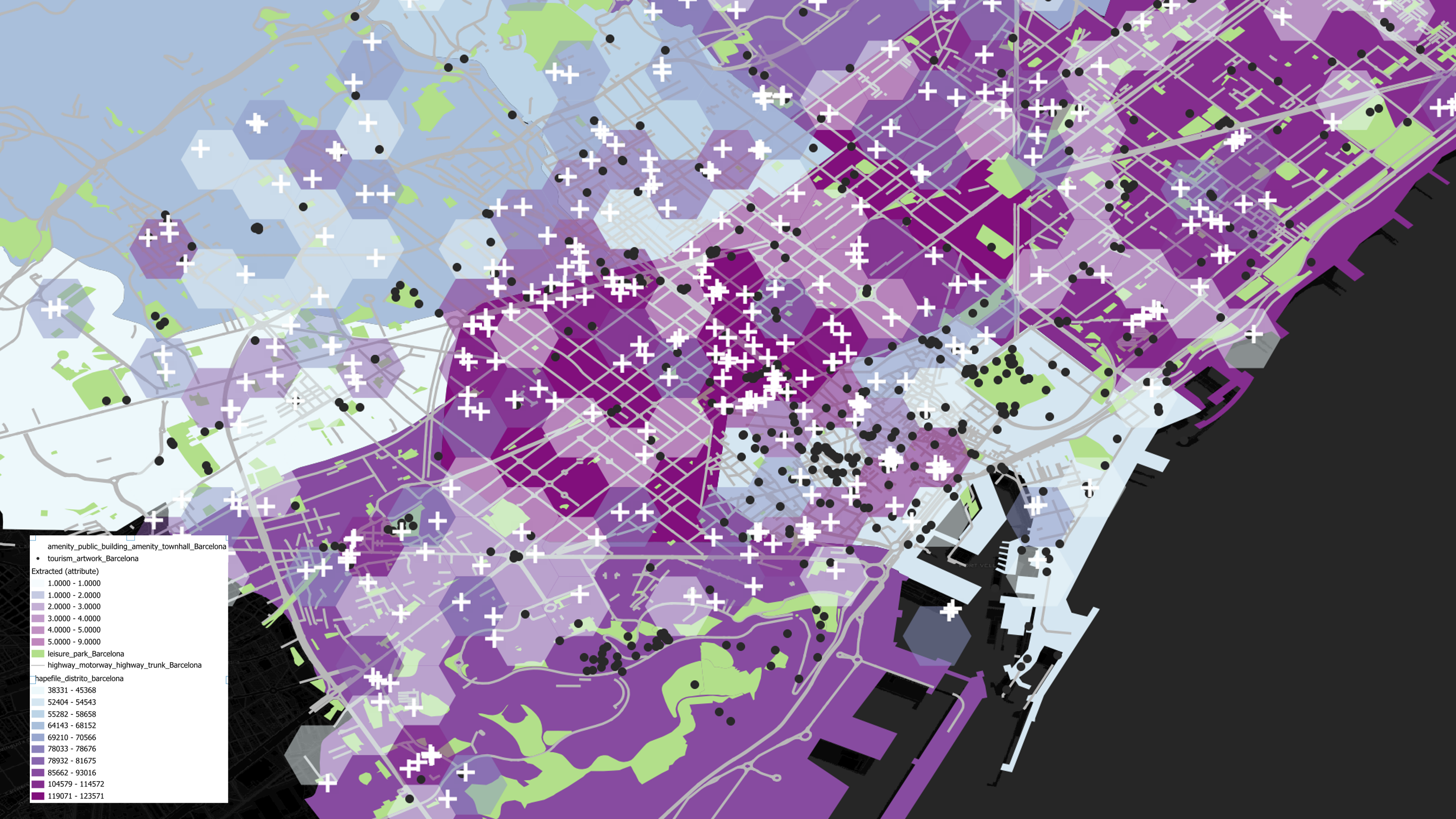
Introduction
Air quality is a problem in many cities around the world, yet it remains largely invisible to the naked eye. This reality struck us deeply when the four of us, having lived in Barcelona, Lagos, Bangkok, and Medellin – our four cities of origin – came together. Amidst our diverse backgrounds and experiences, we uncovered a shared dirty secret: the pressing issue of air pollution. Each city, though unique in its own right, struggles with similar challenges that contribute to poor air quality. In Barcelona, Spain, traffic congestion, industrial emissions, and maritime transport are key factors. Medellin, Colombia, contends with vehicle emissions, industrial sources, and its challenging topography. Bangkok, Thailand, battles traffic congestion, industrial emissions, and agricultural burning. Meanwhile, Lagos, Nigeria, faces its own air pollution woes stemming from traffic congestion, industrial emissions, and open waste burning. These cities, characterized by rapid urbanization, population growth, and inadequate infrastructure, collectively underscore the urgent need for action to address air quality issues. Through our collaboration, we seek to shed light on this often overlooked problem and inspire meaningful change in our communities through public art.

Why art?
In our four cities of Bangkok, Lagos, Barcelona, and Medellin, art has long been recognized as a powerful tool for raising awareness and sparking conversations around social causes. From colorful murals adorning city walls to thought-provoking installations in public spaces, art has the unique ability to transcend language barriers and engage people on a deeper level. Its accessibility and ability to evoke emotions make it an ideal medium for addressing complex issues like air quality.
By using the universal language of art, we can reach diverse audiences, from policymakers to everyday citizens, fostering a sense of empathy and urgency that is crucial for driving meaningful change. Through our public art project, we aim to leverage this inherent strength of art to shine a spotlight on air quality, inspiring action and igniting a collective movement towards cleaner, healthier environments in our cities and beyond.
Methodology
How can we reimagine sensory perception to raise awareness in air quality through innovative forms of artistic illustration?

Types of Sensorial Experiences:
- Sight: large-scale murals depicting scenes related to air quality, such as urban landscapes with visible pollution or representations of clean, green environments. Interactive murals could incorporate augmented reality (AR) or projection mapping technology to allow viewers to interact with the artwork and learn about air quality issues.
- Smell: Installations incorporating scent generators or diffusers to simulate the smells associated with different levels of pollution, from clean air to heavily polluted environments. Visitors could experience firsthand the olfactory effects of air pollution and its impact on the environment.
- Taste: While taste may not be directly applicable to an air quality exhibition, symbolic representations could be explored, such as providing water infused with herbs or fruits known for their air-purifying properties, highlighting the importance of clean air for overall health and well-being.
- Hearing: Audio installations featuring recordings of people coughing or struggling to breathe in polluted environments, accompanied by background noise such as traffic congestion or industrial activity. The soundscape could evoke the auditory experience of living in areas with poor air quality, fostering empathy and understanding among visitors.
- Touch: Installations incorporating mist or fog machines to create a tactile experience representing different levels of pollution. Visitors could physically feel the density of the mist, with variations in intensity correlating to levels of air pollution, providing a sensory representation of the impact of pollution on the environment.
The type of exhibition ultimately depends on the unique characteristics of the location and the public it aims to engage. This approach encompasses both top-down strategies, such as interactive murals, sculptures, and sensorial experiences designed to captivate and educate audiences, as well as bottom-up initiatives that prioritize community involvement and simplicity. Top-down approaches leverage technology and elaborate installations to create immersive experiences that spark conversation and raise awareness about air quality issues. On the other hand, bottom-up strategies involve collaborating with local communities to create murals and art installations using minimal materials, fostering a sense of ownership and empowerment among residents while still effectively conveying the message of environmental stewardship. By tailoring the exhibition format to the specific context and needs of each location, we can ensure that the artwork resonates deeply with the public and drives meaningful engagement and action towards improving air quality in our cities.
Examples
Paint by Number:
Collaborative murals where community members can contribute to the artwork by painting sections based on a paint-by-number system. The murals could depict messages or symbols related to air quality awareness, empowering the community to take ownership of the project.
Showing Particles in the Air through Headsets:
Virtual reality (VR) or augmented reality (AR) headsets could simulate the presence of air pollution particles in the environment, providing a visual representation of the impact of pollution on air quality and human health.
Do you want to decrease the volume?:
The revelation that we can perceive pollution through sound. Intriguing research illuminates a profound correlation between air pollution and the cacophony of noise pollution that permeates our streets. Leveraging the intersection of art and technology, we have the remarkable opportunity to translate this knowledge into a creative symphony of scientific data, harmonizing with the collective consciousness to amplify awareness of climate change among citizens.
Choosing a location:
Choosing art exhibitions that effectively incorporate multiple layers of the city requires a comprehensive methodology that considers various aspects of urban life and environmental factors. Our proposed methodology includes analyzing:
- Amenities & People:
- Identify key amenities and public spaces within the city, such as libraries, community centers, and cultural hubs.
- Analyze the demographics of the surrounding population to ensure that the chosen locations are accessible and inclusive.
- Why it’s crucial: Art exhibitions should be accessible to diverse communities, and locating them near amenities ensures greater visibility and engagement from residents of different backgrounds.
- Concentration:
- Determine areas of high population density or high foot traffic, such as commercial districts, transportation hubs, or popular tourist destinations.
- Consider the potential impact of the exhibition in densely populated areas to maximize exposure and engagement.
- Why it’s crucial: Concentrated areas attract a larger audience and offer greater opportunities for interaction with the artwork, leading to increased awareness and impact.
- Pedestrian Streets:
- Identify pedestrian-friendly streets or promenades that prioritize walking and non-motorized transportation.
- Evaluate the suitability of these streets for hosting art exhibitions, considering factors such as visibility, safety, and existing cultural events.
- Why it’s crucial: Pedestrian streets provide a conducive environment for art appreciation and interaction, allowing visitors to engage with the artwork in a leisurely and safe manner.
- Public Parks & Open Spaces:
- Identify public parks, squares, and other open spaces that serve as gathering points for the community.
- Assess the suitability of these spaces for hosting outdoor art exhibitions, taking into account factors such as size, accessibility, and existing infrastructure.
- Why it’s crucial: Public parks and open spaces offer opportunities for outdoor exhibitions that engage with nature and provide a communal setting for artistic expression, fostering a sense of belonging and connection among residents.
- Areas with Existing Sensors:
- Conduct research to identify locations within the city where air quality sensors or other environmental monitoring devices are already deployed.
- Collaborate with local environmental agencies, research institutions, or community organizations to gather information about the distribution of sensors and the data they collect.
- Analyze the existing data to identify gaps or areas with limited sensor coverage, focusing on neighborhoods or regions where air quality data is sparse or unavailable so art exhibitions can act as sensors.
By incorporating these layers of analysis into the selection process, art exhibitions can be strategically placed within the urban landscape to maximize visibility, accessibility, and engagement, ultimately fostering greater awareness with the artwork and its message.
Funding and collaborative model
This collaborative project brings together a diverse range of participants, including local residents, tourists, students, and businesses. At its core lies an integration of science and art, with individuals from all walks of life contributing to its success. Students, in particular, play a crucial role by using their creative talents to communicate data to governmental authorities, fostering both bottom-up and top-down approach to problem-solving.
Simultaneously, governmental bodies and institutions take on the responsibility of educating the youth about the pressing issues of air pollution and climate change. This educational outreach ensures that future generations are equipped with the knowledge and motivation to enact positive change.
Tech companies and related businesses are enthusiastic participants, offering financial support and sponsorship for the project. They leverage their resources to create engaging campaigns that promote products aimed at mitigating air pollution and safeguarding public health. By adopting innovative approaches to advertising, they effectively raise awareness while fostering meaningful interactions with consumers.
Furthermore, the involvement of governmental and global organizations is pivotal. They provide essential funding and logistical support, enabling the project to expand its reach beyond local boundaries. Through collaborative efforts, this initiative has the potential to make a meaningful impact on a global scale, addressing the urgent challenges posed by air pollution and climate change.
Future implementation
The implementation of this project idea is not limited by geographical boundaries and can be replicated worldwide. While Barcelona offers an ideal starting point due to its abundance of public spaces and vibrant art scene, the methodology behind the project’s area analysis can be applied to any city globally. By conducting thorough analyses of areas rich in public space and art installations, we can uncover the relationship between pollution levels and population density. This allows for the strategic integration of art into public spaces, effectively illustrating invisible challenges, particularly those related to climate change. As such, the project’s methodology holds the potential to promote the use of public art as a means of raising awareness about unseen challenges on a global scale, thus facilitating positive change in communities worldwide.


